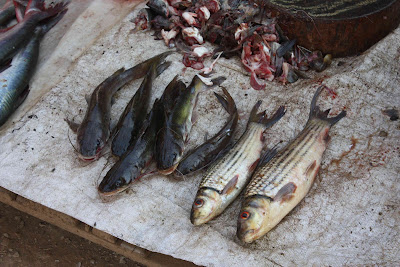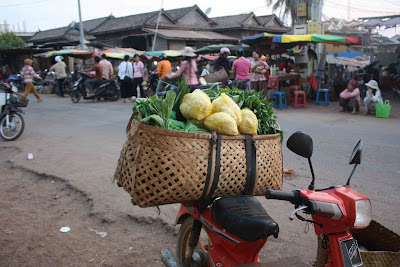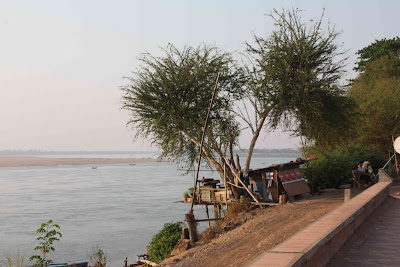Today I woke up, of my own volition, at 5:30 to see Kratie Market come to life. I also thought, so early in the morning, I might get an up-close view of the “fish market” on the dirt streets behind the main market building.
Arriving before 6—it was only a three-minute walk from my hotel—I found myself there before most of the market vendors. It was too dark yet to take photos without a flash, so I wandered around the few square blocks that the market occupies (or, rather, spills over into), exchanged smiles and hellos with a number of people and soaked up the local morning culture that presented itself to me.
At about 6:30 the sun was up and brightening, and the fishmongers were fairly well set-up.
The Mekong River used to boast the second most productive fisheries in the world, behind only the Amazon River, but this is starting to change.
Because of unregulated increases in fish catches in the late 1990s and early 2000s—due in part to illegal fishing methods such as dynamiting and electrocuting parts of the river to kill whatever life is caught in its range (including dolphins)—fewer and fewer fish are being seen around Kratie.
I’ve been told of how dolphins and giant catfish (250 kg in some cases) were often seen from the riverbank in Kratie, and how one could throw a net into the river and nearly be guaranteed a minute later to reel in a full catch. Now, there are only 100 dolphins left in all of Cambodia, the giant catfish is on the verge of extinction, and fish catches are much lower now than in the recent past.
Still, the variety of fish available at the market, which is small, impressed me. I’m only including here about half the different kinds of fish I took photos of at the market.
Closer to the main market area, which I was also told is full of Vietnamese vendors (though I only heard Khmer spoken), there are also a number of flower sellers. Below are two women busy folding the petals of bright pink lotus flowers.
It’s almost startling to see how many young people live in Kratie—there’s been a big baby boom since the Cambodian conflict ended—and as I walked through the market I was assailed by shouts of “hello” from quite a few children. However, I also made at least two kids cry when I offered my own hellos and waved at them…
I spent much of the rest of the morning walking through the central part of Kratie and the paved road along the Mekong River. This doesn’t take a long time…unless you stop a lot to take photos.
I circled back to the river road by my hotel and passed by Wat Kratie, which is under construction and seems to have more dogs on the premises than monks or worshippers.
Early in the morning one can see monks, usually in groups of three, walk in a line through the streets begging for alms. As you can see in the photo below, people take off their shoes before offering them food.
The paved road along the river is lined with impressive rows of shade-giving trees. I’m guessing they were planted by the French in colonial times, as they also tower over old French colonial buildings that are now used by the local government and various NGOs.
Other trees are simply impressive, though they don’t look as if they were planted and cared for by people.
It’s amazing to see some of the houses perched on the riverbank. I wouldn’t want to walk to the back of some of these homes, which don’t look as if they can withstand any more weight than they currently hold.
It’s amazing, too, to see how people make use of the river for so many different things. In the photo below, three men are bathing horses.
I passed a few schools in central Kratie, too, and my wanderings were followed by a hundred children’s voices calling out “hello” all at once.
Another striking feature about Kratie is the local architecture.
The homes are almost universally made of wood (which is treated with “swamp water” so that it can withstand the climate’s heat and moisture) and built upon stilts.
The Mekong River usually doesn’t flood in Kratie, though it did, I was told, in 1999, and during heavy rains the water can come up to one’s waist (as it often does in many Hanoi and Saigon streets).
On the way back to my hotel I came across an old tree with a small altar built into its side. For some reason the old milk cans used to hold incense had a picture of a blond boy: My Boy brand sweetened condensed milk. I couldn’t help but take a photo of it.
The day ended, as it always seems to, with an amazing sunset over the Mekong River.













































That is great!
ReplyDelete